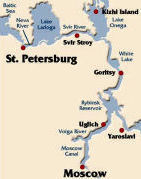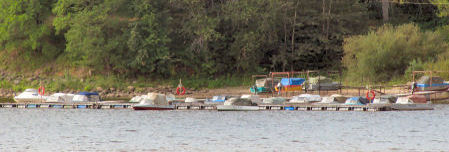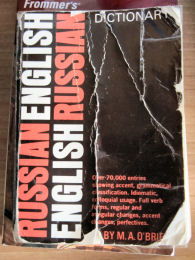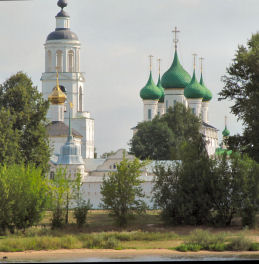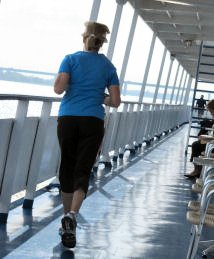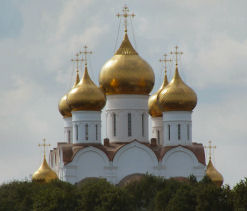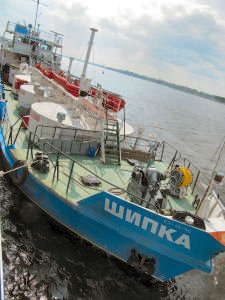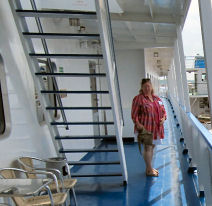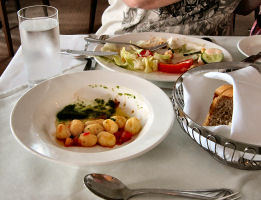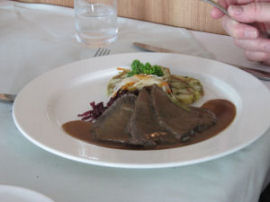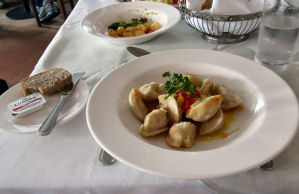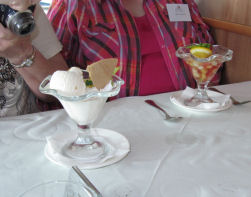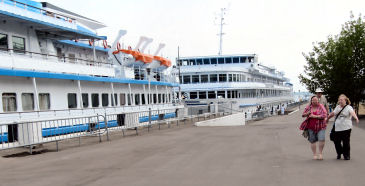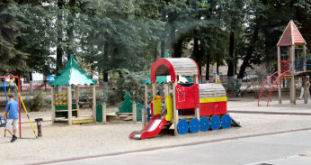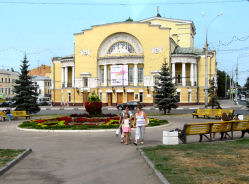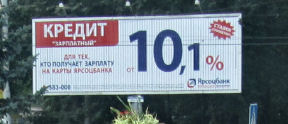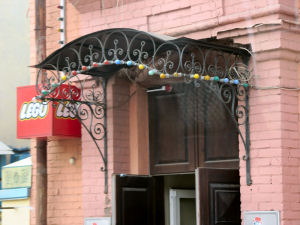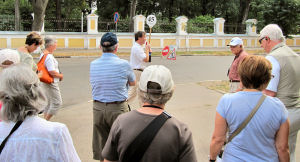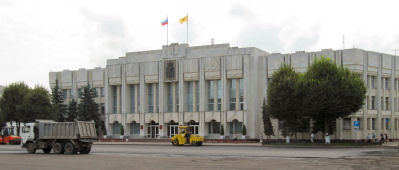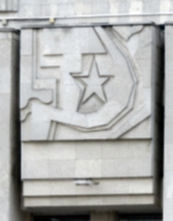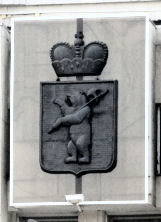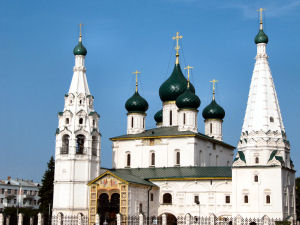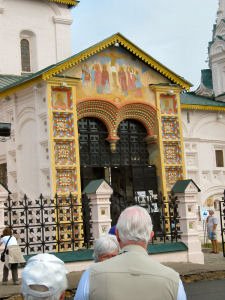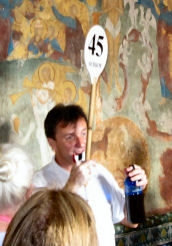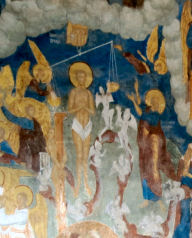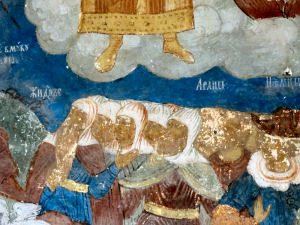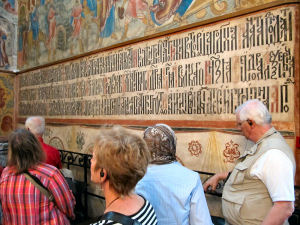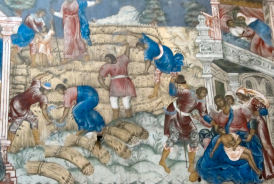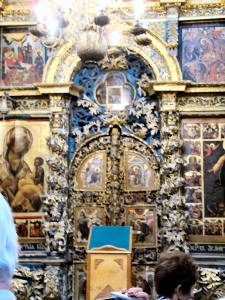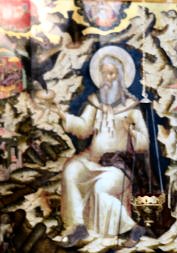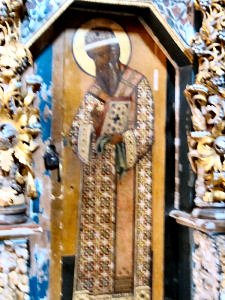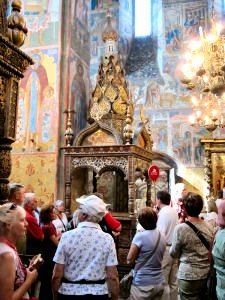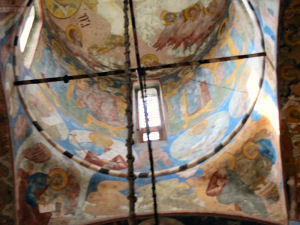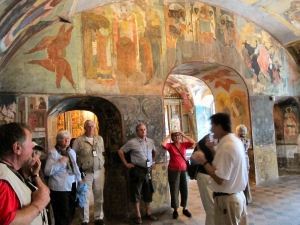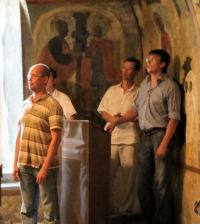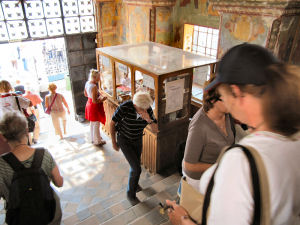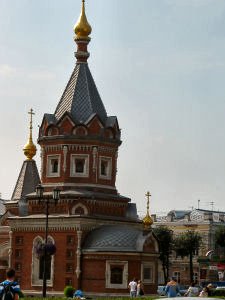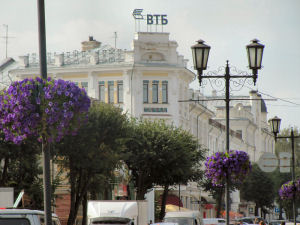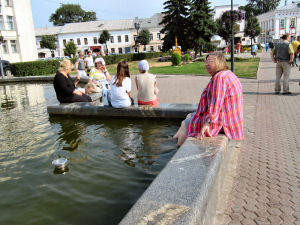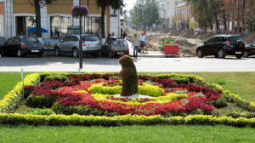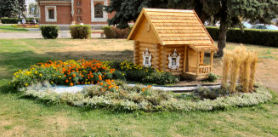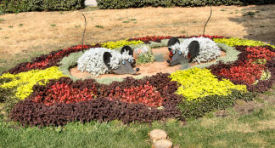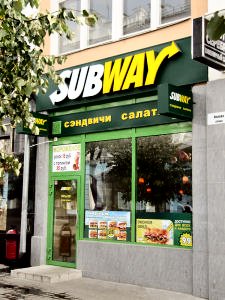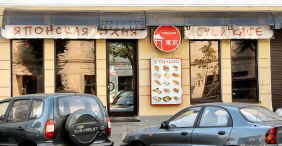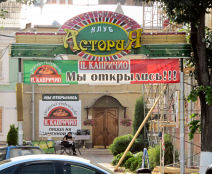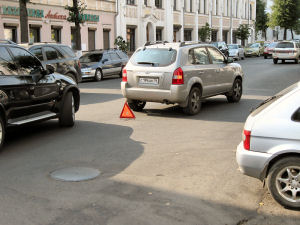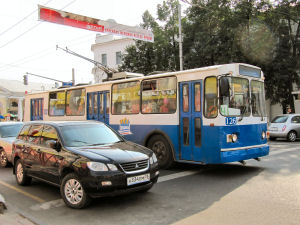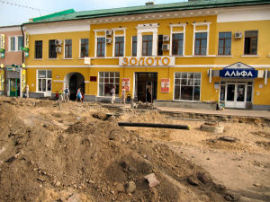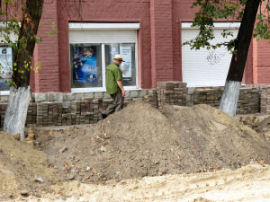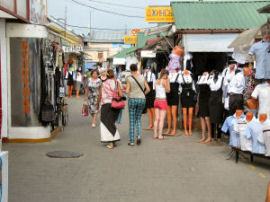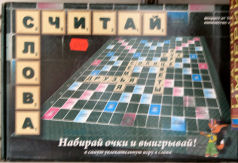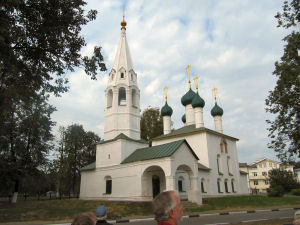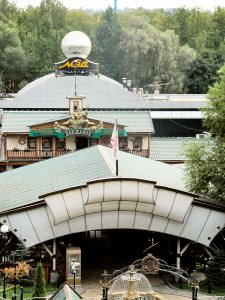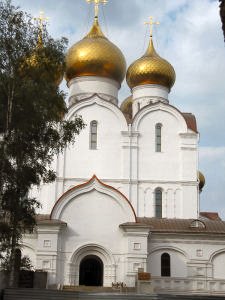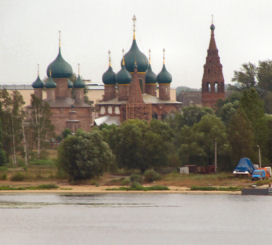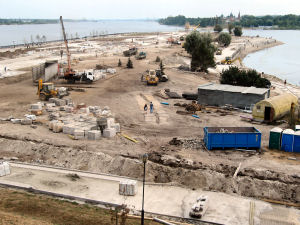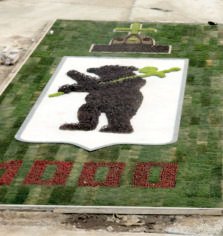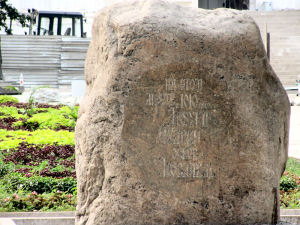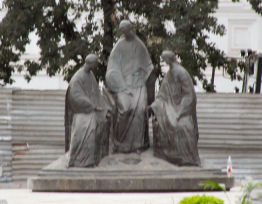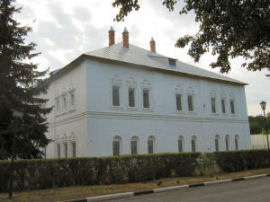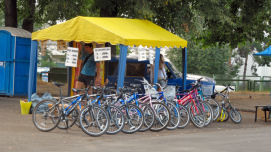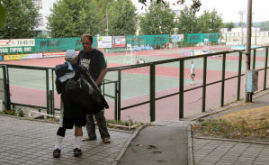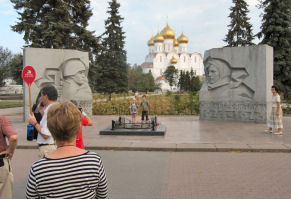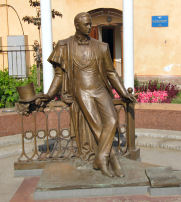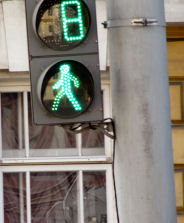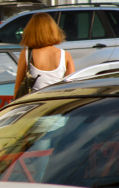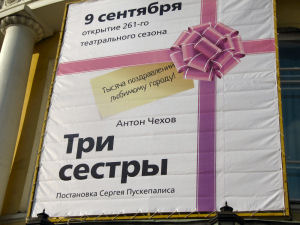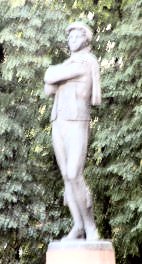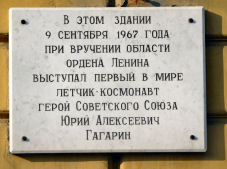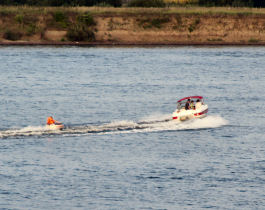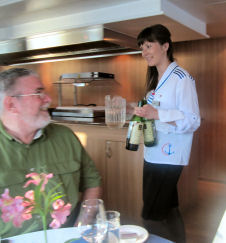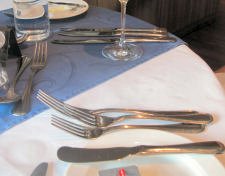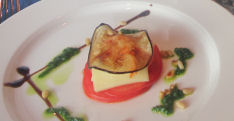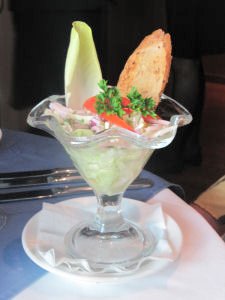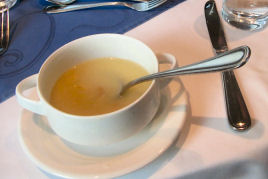I was ready for action. I did not even have a hangover.
At a little after nine o'clock I clambered up to the Sky Bar to attend Liana’s lecture on Gorbachev (gor buh CHOFF) and Perestroika. When I arrived there, I realized that I had forgotten my camera. Oh, well, taking notes would probably be taxing enough for someone in my condition.Liana began by noting that Gorbachev was half Georgian, and half Russian. He implemented many new programs: an anti-alcohol campaign, a new approach to foreign affairs, many political changes, and wholesale economic restructuring. The changes had many unforeseen results.
The years 1985-86 were marked by stagnation under the short-lived leadership of two old men, Andropov and Chernenko. The average age of politburo members at the time was sixty-eight. Gorbachev, by contrast, seemed young and energetic. He came from the south of Russia. Unlike his predecessors he shunned prepared texts and made many extemporaneous speeches. Unfortunately, they were full of grammatical errors.He met his wife Raisa at a party in Moscow while he was attending Moscow State University. He wed her when he was twenty-two. She was much more active than any previous wife of a General Secretary. Some in Russia considered her too interfering and insensitive. She wore diamonds and furs even after economy had gone south. Nina Khrushchev, in contrast, seldom accompanied her husband on his trips abroad, and she dressed very simply.
The country lost ten billion rubles in tax revenue because of Gorbachev’s anti-alcohol campaign. The price of vodka increased dramatically, which inevitably led to a black market.In 1991 Gorbachev and Reagan signed the START treaty, in which the Soviet Union decreased its number of missiles by 50 percent, while the United States cut only 35 percent.
Gorbachev’s theme was “New thinking.” Because of a shortage of cash, the Soviet Union stopped supporting African and Latin American countries with aid. The friendly regimes in the Soviet satellite states in Europe collapsed one after another.
Russians were still taught to distrust all foreigners. They were allowed to travel abroad, but they received strict instructions on how to behave, and they usually were accompanied by an official monitor. Galina, for example, traveled around the Soviet bloc. One woman whom Liana knew was banned from traveling for ten years because she snuck out to one performance of the opera in Germany.The first McDonald’s was opened in Moscow in 1986. People waited in line for three hours to for a taste of a Big Mac. Although one of Gorbachev’s watchwords was Glasnost, which means “openness,” the government still tried to cover up the Chernobyl disaster. A Swedish journalist uncovered the “Big Lie.”
The Moscow News, an English language newspaper of long standing, began to publish juicy items. It was the first example of a freer press in Russia.The election of the Congress of Peoples’ Deputies in March 1989 featured for the first time more than one candidate competing for the same job. All of them were from the Communist Party, but in previous elections only one name had appeared for each office. The people were allowed to watch the legislators on television.
Another of Gorbachev’s favorite words was “Uskorenie (Ускорение),” which means “Speeding up.” Gorbachev’s law on individual labor authorized small businesses. The law on state enterprises emphasized control and promoted self-financing. Co-ops were legalized.
The workers in the Soviet Union demanded higher salaries, and inflation sky-rocketed. The economy went into free-fall. The people with money concentrated on quick profits rather than long-term return on investment. They bought cheap merchandise abroad and sold it in Russia. When the new ruble was issued, millions of people who had dealt only in cash for their entire lives had only three days to exchange their old rubles for new ones, and they had to do it in the bank in their home towns. Many were bankrupted as a result.
The quality of education and medicine deteriorated. There was an accompanying brain drain to the west. Oil prices at the time were very low.
The shortage of staple products in Russia inevitably led to rationing in 1989-90. It became the norm for people to wait in line for three hours for food (and no Big Macs either). People would travel to wherever food was available. “Sausage trains” on which everyone carried his/her allotment of meat were emblematic of the period. Some aid was received from the west, mainly in the form of milk powder.
Russia produced 60 percent of the goods in the Soviet Union and had 90 percent of the resources. In 1991 Gorbachev allowed the other states to become independent. The three Baltic states immediately seceded. The Ukraine followed shortly thereafter. Georgians also wanted independence, but most of the states wanted to remain as a unit.
Gorbachev proposed a new treaty for the Soviet republics in which the central government provided defense and the KGB. Everything else would be handled by the individual states. While he was negotiating it with the leaders of the other republics, a coup occurred in Moscow.
All of the conspirators in the coup had been appointed by Gorbachev. They claimed that he was in “bad health,” which was a transparent lie. Swan Lake and classical music dominated the radio and television broadcasts. The “Emergency Committee” soon announced that Russia was returning to Communism. One-hundred twenty thousand soldiers were deployed to Moscow, but half of them did not obey their orders.
Boris Yeltsin, the president of Russia, defied the conspirators, took over, and invited Gorbachev back. Because the conspirators ordered troops not to shoot, there were only three accidental fatalities. On December 8, 1991, the Soviet Union was officially dissolved, and the Commonwealth of Independent States was established.Gorbachev was never officially ousted, but eventually he resigned because the country that he headed no longer existed. He received less than 1 percent of the vote when he ran for president of Russia in 1996.
Raisa Gorbachev died in 1999, but in 2010 Mikhail Gorbachev was still active in his foundation and frequently appeared in the media.
I enjoyed Liana’s presentation, but I did not think that it quite measured up to the previous two. Maybe the problem was that the material was not as fresh for me.
I did not write down what we ate at lunch, but I took a bunch of photos.During the lecture and lunch we were anchored in the harbor of Yaroslavl. Next to us was a ship that was tasked with filling the Surkov’s tanks. It took hours. Finally at about three o'clock we disembarked and marched over to the Yaroslavl version of bus #45. Polina introduced us to our local guide, Konstantin, and our driver, Mikhail. Polina noted that Konstantin was her friend, and assured us that he was the best guide. He certainly was the most articulate, organized, and knowledgeable of the local guides whom we had encountered. In fact, he provided so much information that it was difficult for me to keep up with him, and if I do say so myself, I am quite adept at taking notes. At the time of our visit Yaroslavl was preparing to celebrate the one-thousandth anniversary of its founding. The oldest Russian book, the epic poem The Tale of Igor’s Campaign, had been discovered in Yaroslavl. The first Russian theater was founded in the city in 1750 by Fyodor Volkov, whose statue was visible from the eponymous square in the city of town. Valentina Tereshkova, the first female cosmonaut, was born and raised in a nearby village. Leonid Sobinov, a famous lyric tenor in the early twentieth century, was a native of Yaroslavl. A statue of Lenin still stood in Yaroslavl’s Red Square. The town’s cathedral, however, was destroyed by the Communists. In the middle ages Yaroslavl had been a wealthy merchant town because of its important position on the Volga. Yaroslavl is two-hundred fifty kilometers from Moscow. Because of the millennial celebration, the federal government was footing the bill for extensive renovations throughout the city. We saw evidence of construction everywhere. The people of Yaroslavl were, according to Konstantin, resigned to receiving no more money from Moscow for another one thousand years.
Our bus’s first stop was the stunning Church of the Prophet Elijah. Before the revolution there had been seventy-eight churches in Yaroslavl, approximately one for every one thousand people. In those days the merchants built the churches in order to show off their wealth. The frescoes in this church were painted in 1680.[1]
The emblem of Yaroslavl is a bear holding a large axe. It was visible in the middle of the yellow flag atop the municipal building across the square from the church. Here is the story. Before Yaroslav the Wise could build his settlement on the Volga, he had to defeat the pagans who resided there. The pagans worshiped a bear god, whom they kept in a cage. Yaroslav proposed that he fight against the champion of the pagans in individual combat, winner take the site. They agreed and nominated the bear god. Yaroslav did battle with the bear and slew it with his axe. So why, inquiring minds want to know, is the bear holding the axe? Shouldn’t it be buried in his neck or his chest? I don’t know. Maybe when Yaroslav showed up for the fight with his battleaxe in hand, the pagans came up with one for the bear, too. We went inside the church. Konstantin told us that the fresco of the Last Judgment visually prortrayed that Jews, blacks, and all foreigners were doomed to hell. On another wall the unusual inscription in Old Slavonic detailed the history of the Skripin family in large Slavonic lettering. Konstantin said that he could not read it, but he knew that the red letters indicated the start of sentences.
The church had served as a museum of atheism from 1937 until the fall of the Communists. The people had tricked the government into preserving the frescoes and icons as examples of the decadence of the faithful. The fresco of “Harvesting” is very famous for some reason.
The most important icon in any Russian iconostasis was the second one from the middle on the right on the local level. It identified the namesake of the church, which in this case was Elijah.[2] The iconostasis in this church contained an extra half level of icons of family history. Peter the Great’s father, Czar Alexei, and the last czar, Nicholas II, visited the church. The ornate special boxes were constructed for the use of the czars.We were allowed a few unsupervised minutes to explore the church on our own. The ornamentation in this church was certainly elaborate. It definitely put to shame anything that we had previously seen. It was true, however, that we had been allowed inside even one church in St. Petersburg.
The group then trooped through a side door and around a corner to the chapel to listen to a short concert by a group named Виват. I do not think that the name means anything in Russian. It must either be a proper name, or maybe it could be a reference to the Latin word that meant “let it live.”
Konstantin told us that the acoustics were best near the stove, so that was where I positioned myself. The acoustics were indeed very good there, but the lighting from that angle was beyond horrible. I was not a good enough photographer to realize the problem in time to do something about it. My photos of the singers were rather disappointing.
The first number was a folk song about a robber who repented and became a monk. I think that the second song was a sacred one. I had enjoyed the previous choirs, but I thought that these guys were exceptionally good. I don’t think that a great deal of thought went into the selection of their wardrobe, however. Sue purchased two of their CD’s.
After we had exited the church, Konstantin explained that chapels were often erected at crossroads. Chapels were fundamentally different from churches. Churches had priests and altars. Chapels were strictly for private prayer.Alexander Nevsky allegedly descended from Yaroslav the Wise. He lived more than two centuries later, so he would have been quite a few generations removed from the bear-slayer.
Mikhail then transported us to a lovely square in the center of the retail area. We were allotted quite a bit of free time just to wander around. My first objective was to locate an ATM. The one that was nearest the square only provided instructions and prompts in Russian. I had left the Russian phrase book, which had a page on banking terms, in the cabin. I wished that I had brought it with me. Without it, doing battle with the machine was beyond my abilities. I was like Yaroslav without his axe.
Fortunately a much larger bank was within sight. I hustled over to it and found three bankomats there. At least two of them could be operated in English. I withdrew another two thousand rubles and gave half to Sue.The park in the middle of the square was full of interesting exhibits. I took lots of photos of the colorful floral displays and topiary. Sue found a fountain in which she could soak her feet.
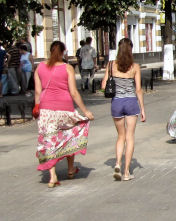 | 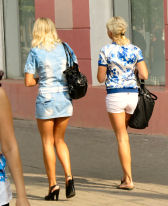 | 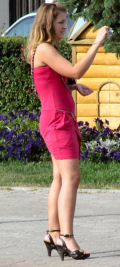 | 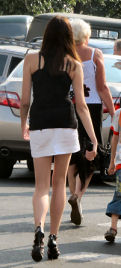 | |||
| A warm day ... | ... in Yaroslavl ... | ... brought out ... | ... the legs. | |||
I walked up and down a few of the streets in an attempt to get a feel for the city. Only a few times did any of the stores capture my attention. I snapped a few photos of things that I never expected to see.
The most unexpected sight by far, was the condition of the street on which the town’s major market was located. It was completely torn up. Not only could no autos use the street. You could not even walk across it.
The market itself was full of cheap stuff from Turkey and China. This kind of place seemed to be the Russians’ answer to Wal-Mart except that there were dozens of small vendors.
As I was about to leave the market, my attention was drawn to a Russian Scrabble game in the window of a toy store. In Russian it was called считай слова, which means “total up the words.” Russian has two peculiar letters, the soft sign (ь) and the much less common hard sign (ъ). Neither has an intrinsic sound of its own. They never begin a word, and they only affect the sound of letters that proceed them. The silent e and a few other letters have a similar role in English. The illustration on the cover of the box appeared to indicate that the soft sign was worth five points. The hard sign is used much less than any English letter. I wondered how much it was worth, but I was not about to shell out five hundred rubles to find out. Bus #45 drove through Epiphany Square. There we saw the Church of the Epiphany with its green domes and brick façade. A monument to Yaroslav the Wise was nearby. I neglected to photograph both the church and the monument. After we saw the Church of Our Savior Facing the Old Town, Konstantin filled in a little of the geographical background information about the city of Yaroslavl. It is at the junction of the Volga and Kotorosl rivers. Lake Nero is about thirty-five miles to the south.
Many churches in Russia have been named after St. Nicholas. I suspected that this was probably the same person who became the basis for Santa Claus traditions.
A fire in 1507 destroyed the kremlin in Yaroslavl. A kremlin is just a fort. The date made me realize that Russia has been a unified country for quite a long time by European standards. Italy only became a state in 1870, and there were still two independent nations within its borders. There was an empire in western Europe starting in 800, but inside and outside of it innumerable sovereign princes were constantly warring over territory. The Balkans are still trying to sort it out. Russia seemed to have avoided all of that internal warring. The Ascension Cathedral was being rebuilt in 2010. It was the white one with bright gold domes. They were made of gilded iron.The “old believers,” the ones who signed themselves with two fingers, did not want to change at the time of Peter I. They would rather burn than reform. They were persecuted and formed small communities in the east. They have recently received two churches in Yaroslavl.
We stopped at a park near the Volga River. Konstantin gave us the option of joining him for a guided walk around the park or to stay in the bus. I opted to walk; Sue took the bus. We came to the stone that marked the spot on which legend says that Yaroslav founded the town. On a previous tour Edward Rutherfurd, the author of the novel Russka, had told Konstantin that the writing on the stone stated that Yaroslav founded the town in 1010 “on this site.”We caught a glimpse of the modernistic statue of the “trinity,” which, according to the sculptor, was based on a famous icon in the Tretyakov gallery. The local people protested that it did not fit in with the rest of the park. UNESCO protected the site.
We walked as far as the river. Far below us we could see a lot of construction. A bear with an axe had been depicted with flowers. Konstantin told us that it was planted only a week before we arrived. The czar once stayed in the metopolitan’s house. It was later converted into an icon museum.A Marriott Hotel was planned for the edge of the park near the river. The official website of the Yaroslavl region, which surely needed an updating, stated that it would be operational in 2009, but ground had not yet been broken when we were there a year later.
We saw a second church dedicated to Elijah.
We spent a few minutes at the impressive World War II memorial, which had a perpetual flame. One side honored the men who fought; the other side paid tribute the women who supported them. While we were there one person or group after another posed for pictures there. Many cities have similar monuments to those who helped win what the Russians call “The Patriotic War.” We then rejoined the rest of the group in the bus. We drove past a wall that surrounded a monastery; Konstantin assured us that it was not a kremlin. We saw a statue to Leonid Sobinov, a famous tenor. I later got some good pictures of it. Konstantin told us a joke. A crash occurred on the streets of Moscow between a poor man’s Lada and a gangster’s Mercedes. The gangster insisted that the poor man give him everything that he had. The poor man said that he had very little. “What about your relatives?” “Well,” said the poor man, “my son is a chicken farmer.” “OK. We will take his farm. Call him on the phone.” A few minutes later helicopters arrived, heavily armed commandoes parachuted from them, surrounded the gangsters, and arrested them. A young man approached to the poor man and said, “Papa, you have to remember that I am a commander of the Eagles, the Russian special forces, not a chicken farmer.” We terminated the tour in what was supposed to be an art gallery. The obvious reason that we stopped was so that people whose wallets and purses were weighted down with rubles could shed a few thousand on lacquer boxes. Ivan, who spoke English very well, explained that there were four basic schools of design associated with the four villages famous for their lacquer boxes. Fedochna was ranked number one and used mother-of-pearl to achieve one color, Kholni, which accounted for 70 percent of the items on display, Palekh, and Stol. The boxes were made of papier mâché, not wood. The base was usually black; the inside was traditionally red. The artists used a one-hair brush to paint the scene. Three captions should appear on the bottom of the box: the name of scene, the name of the village, and the name of artist. One had to be careful; knock-offs abounded.
If any doubt remained about the nature of the “art gallery,” it was dispelled by the three card tables to the side. They advertised that they took “any currency” as well as credit cards.
At the first opportunity I escaped and walked around outside. I took some pictures of the theater, some statues, and the column. At one point I happened to be standing on the sidewalk near a well-endowed young lady who was walking back and forth and talking on a cell phone. On the front of her long sleeveless white shirt were the words (in English) “Barbie wants to be me.”[3] I exercised great subtlety in attempting to take a photo of her and the shirt, but in the only one that was usable she was walking away from me.Konstantin told us about one of the town’s heroes, Paul Demidov. In the eighteenth century he owned mines and factories throughout Russia. He established a hospital for poor people, a college, and many other public institutions. A column dedicated to him as a Citizen of Honor of Yaroslavl was erected on the one-hundredth anniversary of his death. The Communists destroyed it for something valuable that they thought was inside it. It was actually hollow. The town constructed a replica in 2005.
Approximately six hundred thousand people lived in Yaroslavl. The city still had a sizeable amount of industry, including a refinery. It boasted three universities (a classical one, one for teachers, and a technical one) and two academies. Among its seven sister-cities was Burlington, VT. The bus stopped near a building long enough for me to read the sign. It was a tanning studio that charged eight rubles per minute. My wallet contained enough for two hours.The tour of Yaroslavl was fun and informative, but it was also confusing. Except when we were actually in sight of the river I had no idea where we were. I like to have some kind of framework on which to place things. This probably was mostly just the result of trying to jam too much into too short of a time period.
I liked Yaroslavl. I wish that we had been able to spend the whole day here. It would have been nice if we could have somehow avoided wasting the time that the ship spent getting refueled.
When we were back aboard the Surkov, I discovered that our cabin was being made up. So I wasted some time on deck. We passed a location that had towns on both sides of the river with the predictable churches with the predictable onion domes.
I discovered that one of my camera batteries was missing. It was not the original battery; it was one of the replacements that I had purchased separately. I asked at the reception desk. The lady there looked in the lost and found box, but she found no batteries. I must have slipped it into the pocket of my nylon warm-ups. On previous trips items had slipped out of the pockets of my nylon pants. I was not too disheartened by this turn of events. I would just need to be careful to keep both of my remaining batteries fully charged. I had not been at all impressed by the number of shots that I was able to get from the replacement batteries. The original Canon battery seemed to hold a charge much better. At 7:15 I sat in on the port talk by the cruise director, also named Konstantin. The ship had now backtracked and was passing through the Rybensk Reservoir. Our next destination of Uglich was once famous for its Chaika watch factory. Khrushchev once bragged that they were as good as Swiss watches and even faster.Tuesday evening would feature the guest talent show. They were looking for volunteers. I wondered if people would be impressed that I could bend my left thumb back to my arm. I could also put on a demonstration of how I could wiggle my nostrils and my ears. I could even wiggle one ear at a time. Would it not be selfish to deprive the passengers of this entertainment? I decided not to volunteer; people might get too envious.
For supper I ordered the tomato mozzarella tower as an appetizer, garlic soup with almonds, and lamb stew with rice. The best part was the soup.This was movie night. Konstantin had personally chosen Onegin as the movie. It starred Ralph Fiennes and Liv Tyler. It was directed by Fiennes’s sister. The big attraction was that it was to be accompanied by popcorn! I went up to the Sky Bar with Tom and I sat on a bar stool next to him for a while.
Unfortunately, there was not enough popcorn, and it seemed soggy to me. It could have used some salt, too. The Coke Light that they served on board did not taste like Diet Coke to me either.Sitting by the bar had a big disadvantage. The bartenders were making so much noise that I could not hear the dialog. I saw Sue sitting in a chair by the wall, and I abandoned my stool to join her. My new location lost its allure when a woman with big hair took a seat in front of me and blocked my view. I had to crane my head to the left.
The movie itself was just awful. There was a duel early on, but aside from that there was no action at all, not even a car chase. The scenery in St. Petersburg and its environs was enjoyable, but otherwise it was an unbearable chick flick. I left before the end and went to bed.
[1] That seemed old, but it was three full centuries after the start of the Italian Renaissance. Caravaggio had been dead for seventy years!
[2] I could think of no examples of Roman Catholic churches that were named after Old Testament figures. We did not see any others in Russia either. Maybe since Elijah reportedly never died and appeared in the Transfiguration, he was considered by some as a New Testament saint.
[3] The shirt might have been right, too.
